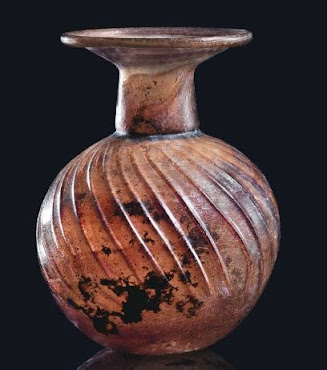The glassworker fused together glass canes in multiple colors to form a single gob. Inflating the gob resulted in vertical bands of alternating dark blue, purple, green, and white. If you look closely you’ll see the fluid gradations within each band of color—for example, a large band transitions from pure white into icy blue and then stormy blue as it begins to mix gradually with the adjacent dark blue glass. The effect is almost hypnotizing.Another Getty piece, a multi-sectioned bowl:
Like the color-band flask above, this bowl has alternating bands of color, but here a different technique achieved the striped effect. To make this bowl, the glassworker wound a trail of hot white glass around a purple glass gob. Marvering it (rolling it against a slab) fused the trail into the gob to create a smooth surface. After marvering, the glassworker partially inflated the gob into a one-part open mold, called a dip mold, whose interior had been carved to imprint the vertical ribs around the vessel’s body. The partially inflated gob was removed from the mold and fully inflated.Notice the experimentation with different combinations of fusing different colored pieces, blowing, molding, painting, and more. As in this ribbed bowl, which was partially blown before the white piping was added, and then finished by being blown into a four-piece mod.We even know the names of a few of Rome's most famous glass-makers; this piece is signed by Ennion, That's a Semitic name, so he was probably from Syria.
Painted "circus cups" found in a queen's grave in Denmark, 3rd century AD. Glass was an important Roman export, sold not only to barbarians but also to Persia and India.Here's a Roman vessel from the 2nd century AD found in Afghanistan. The painting shows a gladiator.Late in the first century BC another major invention was made, cameo glass, which was made by fusing lumps of white glass to a dark vessel and then carving the white glass into the finished shape. This is the famous Portland Vase, which in the 1700s was widely considered one of the most perfect works of classical art.
The variety of Roman glass is stunning, as is the number of vessels that survive.



















1 comment:
Lovely piece with gorgeous illustrations!
JEL
Post a Comment